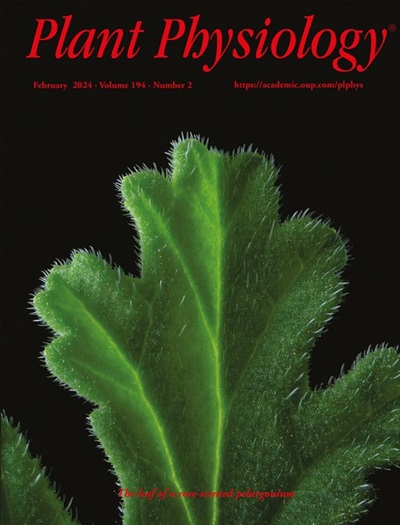限制干旱生境中沙漠灌木生长和维持其生存的水力机制
IF 6.5
1区 生物学
Q1 PLANT SCIENCES
引用次数: 0
摘要
木本植物物种的生长和生存主要受进化和环境因素的影响。然而,人们对应对生长限制并使沙漠灌木在干旱生境中生存的水力机制知之甚少。为了揭示这些水力机制,本研究采用了在中国宁夏腾格里沙漠东南边缘不同土壤水分条件下生长的 9 年、31 年和 56 年树龄的科尔沁草(Caragana korshinskii)。在无水生境中,柯尔金娜的生长主要受土壤水分而非灌木年龄的限制,这表明在干旱条件下灌木生长前保持存活率的重要性。同时,较高的血管密度、较窄的血管和较低的木质部水导率表明灌木在干旱条件下增强了水力安全,降低了水力效率。重要的是,木质部水力结构的变化介导的木质部水力传导性调节了柯氏灌木的光合碳同化和生长。我们的研究表明,木质部水力安全和水力效率的协同变化是干旱条件下限制柯辛斯基树(C. korshinskii)生长和维持其存活的水力机制,为沙漠灌木在干旱生境中的生长和存活策略提供了启示。本文章由计算机程序翻译,如有差异,请以英文原文为准。
Hydraulic mechanism of limiting growth and maintaining survival of desert shrubs in arid habitats
The growth and survival of woody plant species is mainly driven by evolutionary and environmental factors. However, little is known about the hydraulic mechanisms that respond to growth limitation and enable desert shrub survival in arid habitats. To shed light on these hydraulic mechanisms, 9-, 31-, and 56-year-old Caragana korshinskii plants that had been grown under different soil water conditions at the southeast edge of the Tengger Desert, Ningxia, China were used in this study. The growth of C. korshinskii was mainly limited by soil water rather than shrub age in non-watered habitats, which indicated the importance of maintaining shrub survival prior to growth under drought. Meanwhile, higher vessel density, narrower vessels and lower xylem hydraulic conductivity indicated that shrubs enhanced hydraulic safety and reduced their hydraulic efficiency in arid conditions. Importantly, xylem hydraulic conductivity mediated by variation in xylem hydraulic architecture regulated photosynthetic carbon assimilation and growth of C. korshinskii. Our study highlights that the synergistic variation in xylem hydraulic safety and hydraulic efficiency is the hydraulic mechanism limiting growth and maintaining survival of C. korshinskii under drought, providing insights into the strategies for growth and survival of desert shrubs in arid habitats.
求助全文
通过发布文献求助,成功后即可免费获取论文全文。
去求助
来源期刊

Plant Physiology
生物-植物科学
CiteScore
12.20
自引率
5.40%
发文量
535
审稿时长
2.3 months
期刊介绍:
Plant Physiology® is a distinguished and highly respected journal with a rich history dating back to its establishment in 1926. It stands as a leading international publication in the field of plant biology, covering a comprehensive range of topics from the molecular and structural aspects of plant life to systems biology and ecophysiology. Recognized as the most highly cited journal in plant sciences, Plant Physiology® is a testament to its commitment to excellence and the dissemination of groundbreaking research.
As the official publication of the American Society of Plant Biologists, Plant Physiology® upholds rigorous peer-review standards, ensuring that the scientific community receives the highest quality research. The journal releases 12 issues annually, providing a steady stream of new findings and insights to its readership.
 求助内容:
求助内容: 应助结果提醒方式:
应助结果提醒方式:


